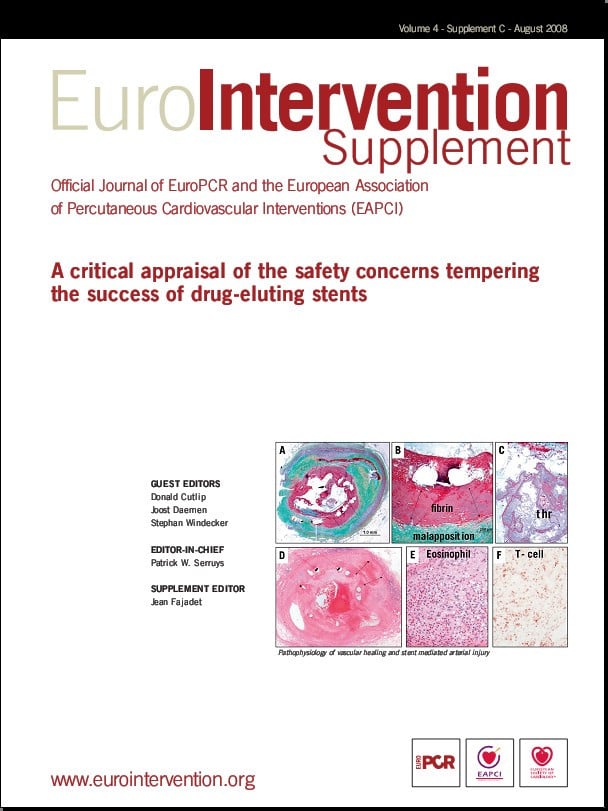Abstract from the SCAAR registry
Abstract
Background: Recent reports have indicated that there may be an increased risk of late stent thrombosis with the use of drug-eluting stents, as compared with bare-metal stents.
Methods: We evaluated 6033 patients treated with drug-eluting stents and 13,738 patients treated with bare-metal stents in 2003 and 2004, using data from the Swedish Coronary Angiography and Angioplasty Registry. The outcome analysis covering a period of up to 3 years was based on 1424 deaths and 2463 myocardial infarctions and was adjusted for differences in baseline characteristics.
Results: The two study groups did not differ significantly in the composite of death and myocardial infarction during 3 years of follow-up. At 6 months, there was a trend toward a lower unadjusted event rate in patients with drug-eluting stents than in those with bare-metal stents, with 13.4 fewer such events per 1000 patients. However, after 6 months, patients with drug-eluting stents had a significantly higher event rate, with 12.7 more events per 1000 patients per year (adjusted relative risk, 1.20; 95% confidence interval [CI], 1.05 to 1.37). At 3 years, mortality was significantly higher in patients with drug-eluting stents (adjusted relative risk, 1.18; 95% CI, 1.04 to 1.35), and from 6 months to 3 years, the adjusted relative risk for death in this group was 1.32 (95% CI, 1.11 to 1.57).
Conclusions: Drug-eluting stents were associated with an increased rate of death, as compared with bare-metal stents. This trend appeared after 6 months, when the risk of death was 0.5 percentage point higher and a composite of death or myocardial infarction was 0.5 to 1.0 percentage point higher per year. The long-term safety of drug-eluting stents needs to be ascertained in large, randomized trials.
N Engl J Med 2007;356:1009-19.Copyright © 2007 Massachusetts Medical Society
Acknowledgement
Reprinted from The New England Journal of Medicine Volume 356:1009 March 8, 2007 with permission from Massachusetts Medical Society.
Commentary on the SCAAR registry
In the initial report of the SCAAR registry, including patients treated between January 2003 and December 2003, the authors demonstrated and 18% increase in the long-term risk of death in patients treated with drug-eluting stents (DES) as compared to those treated with bare-metal stents.1 Additionally, the analysis of the composite of death and myocardial infarction indicated a lower event rate during the first six months but thereafter an increase of approximately 20%. The authors warned of the possible detrimental effects of an unrestricted DES use in the long term. The high quality of the data reflecting real world clinical practice on a national scale without the confounding impact of scheduled angiographic follow-up reinforced the worrying findings presented at the so-called DES firestorm in 2006. As a result, DES use decreased worldwide. A remarkable reaction on the part of the medical community to a single publication and the findings of a non-patient level based data meta-analyses of the several pivotal randomized controlled trials.2 More in particular since the results were disputed by several randomised controlled trials comparing sirolimus-eluting stents or paclitaxel-eluting stents and bare-metal stents, which showed no significant differences in the rates of death.3-6 These latter results were further confirmed in several pooled analyses of individual patient level data from these trials.7-9 Additionally, the Western-Denmark registry (n=12.395), Ontario registry data (n=13,353), and data from the state of Massachusetts in the United States demonstrated a trend towards a lower mortality rate following DES in the first months, which was maintained up to two years.10-12
Merely one year later, in the longer-term follow-up of the SCAAR registry, including patients treated in 2005, the initially reported increased mortality risk in patients treated with DES was no longer present.13 The landmark analyses of 2003 and 2004 showed no difference in death and MI over the first six months and an increasingly detrimental long-term effect in the DES patients over the ensuing years of follow-up. In contrast, the 2005 landmark analysis showed a risk reduction of 31% with DES over the first six months and no late unfavourable effects over the two subsequent years. Comparing the baseline characteristics of the original 2003-2004 cohort published in the NEJM compared to the baseline characteristics of the cohort recruited between 2003 and 2005 did not reveal spectacular changes - no matter how remarkable was the increase in DES use. Between 2003-2004 and 2005, DES use increased from 22% in 2003 to 37% in 2004 and reaching 53% in 2005. As a possible explanation for the late catch-up in death and myocardial infarction rates in the Swedish registry, the authors suggested that the currently prescribed duration of dual antiplatelet therapy ranging between six and 12 months would be insufficient; which was suggested to increase the rates of late death and myocardial infarction.
In the past year the scepticism about DES tempered. The use of DES slightly increased again, new DES (Xience V®) received FDA approval, and the N.I.C.E. recommendation not to use DES any longer was reversed. We look forward to an update on the long-term follow-up of the 2003-2005 Swedish cohort, possibly extended with data from patients treated in 2006, including data on the outcome of those receiving long-term dual antiplatelet therapy.

